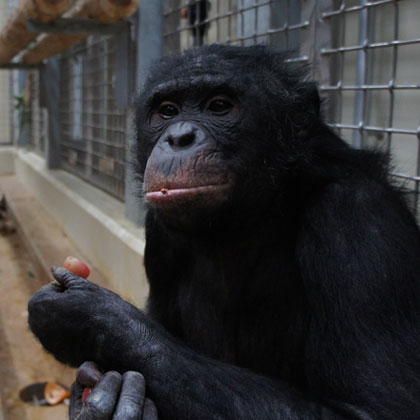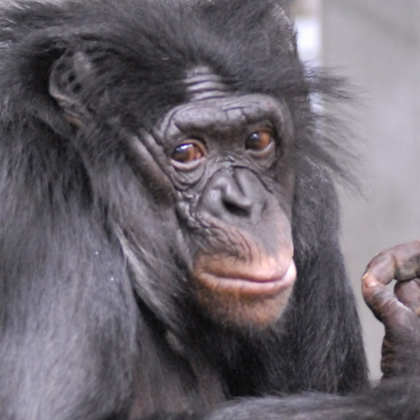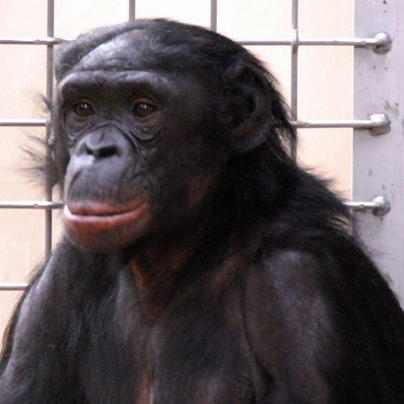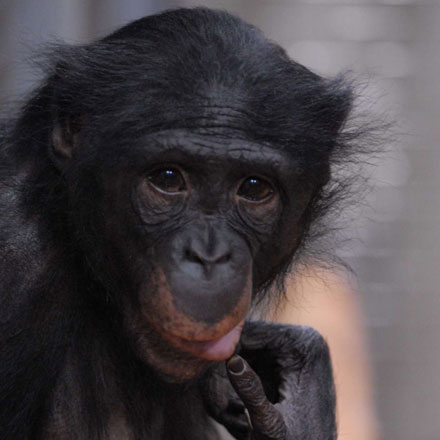Four bonobos have arrived at Kumamoto Sanctuary.
3 Dec 2013
About bonobos
Along with chimpanzees, bonobos are the closest living relatives of humans. Wild individuals live only in the Democratic Republic of the Congo (DRC) in Africa, where the population is decreasing and is threatened by extinction. Moreover, the number of captive individuals is small, around 90 each in the United States and Europe. There were no bonobos in Japan before we received the four individuals. Dr. Kano of Kyoto University started pioneering work on wild bonobos at Wamba in the DRC in 1973, and his longitudinal research is well-known worldwide.Background of the imported bonobos
Our four bonobos came from the San Diego Zoo. The name sex, and, age are as follows.
Name: Junior
Sex: Male, Birthday (age): 01/14/1995 (18)

Name: Connie-Lenore
Sex: Female, Birthday (age): 02/03/1982 (31)

Name: Lolita
Sex: Female, Birthday (age): 04/20/1989 (24)

Name: Ikela
Sex: Female, Birthday (age): 11/27/1991 (22)
KS obtained approval from the Association of Zoos and Aquariums, exchanged transfer agreements with the San Diego Zoo, and took the necessary official steps to import the bonobos. The bonobos arrived at KS on November 27, 2013, and the media were allowed limited access to them on December 3, 2013.
Significance of the comparative study of chimpanzees and bonobos
Although chimpanzees and bonobos are physically similar, their social organization and behaviors are different. In short, chimpanzees are aggressive, form male-dominated societies, and use a variety of tools in the wild. Bonobos are relatively peaceful, form female-dominated societies, and use tool less frequently in the wild than do chimpanzees. The investigation of these differences will provide a better understanding of the evolutionary origins of human cognition, behavior, and societies. Chimpanzee behavior and social attributes have been investigated extensively in Japan and in other countries; however, few investigations have focused on bonobos. We do not consider the comparison of chimpanzees and humans sufficient to shed light on the origins of human nature; we believe it is necessary to compare bonobos, chimpanzees, and humans to arrive at a true understanding of the human condition. The first scientific investigations of bonobos in Japan conducted at KS will produce several novel findings.
Outline of the research plan
KS will conduct non-invasive research using comparative cognitive and behavioral techniques. Our goal is to clarify the cognitive mechanisms and behavioral basis of thought, language, memory, and sociality. We will emphasize three points.
First, the comparative studies in bonobos will use the techniques currently used in ongoing chimpanzee cognitive research. The Primate Research Institute of Kyoto University has been conducting comparative cognitive studies in chimpanzees, called the “Ai project" since 1978. The results have revealed that chimpanzees recognize numerals and have excellent memories. KS conducts cognitive research on chimpanzees under a variety of conditions using touch-panels, eye-trackers, and observations of tool-use. We plan to use the same methodologies in the bonobo studies and compare the performances of chimpanzees and bonobos. Ongoing chimpanzee projects include transmission of technologies and knowledge through generations, time-perception to investigate the evolution of mental time, and empathy and altruistic behavior.
The second point is that there are two axes of comparison: between individuals living in the wild and in the laboratory (Africa vs. Japan, respectively), and between chimpanzees and bonobos. Our team is conducting a longitudinal study on wild chimpanzees in Bossou-Nimba, Guinea in West Africa, and members of our team have participated in a longitudinal study of wild bonobos at Wamba since 2010. These studies will provide the basis of our integrative comparison of individuals living in Africa and in Japan and of the chimpanzee-bonobo comparison.
Third, welfare and conservation is integral to our research activities. The results of our research on animals in captivity are used to ensure their safety and happiness and improve the quality of their lives, and our fieldwork in Africa contributes to the conservation of chimpanzees and bonobos. Furthermore, we plan to conduct studies in captivity and in the wild that promote welfare and conservation activities, and engage in the education of young people to foster our goals for welfare and conservation.
In summary, our goal is to promote the scientific understanding of human nature by studying bonobos for the first time in Japan.
KS is not open to the public for safety reasons.